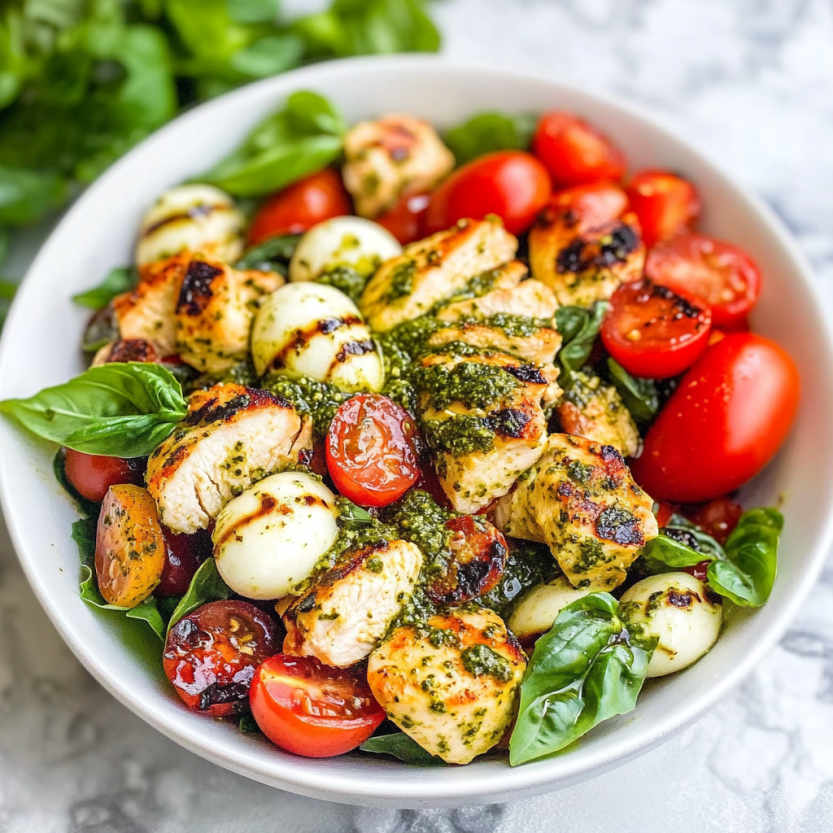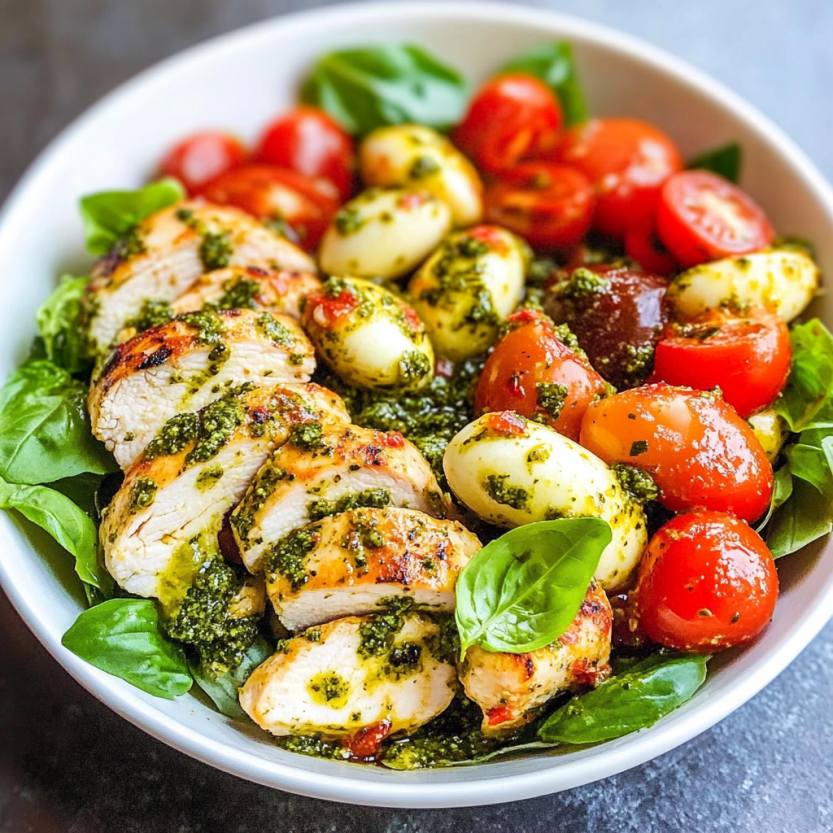 Bookmark
Bookmark
This pesto chicken caprese salad combines juicy chicken coated in fresh basil pesto with bright tomatoes and creamy mozzarella pearls for a perfect summer meal. The homemade pesto elevates this dish beyond ordinary salads, infusing every bite with aromatic herbs and rich flavor.
I first made this recipe during a sweltering summer afternoon when turning on the oven felt unbearable. The combination was such a hit that it has become my go to impressive yet effortless dish for impromptu dinner guests.
Ingredients
- Fresh basil leaves crucial for authentic pesto flavor pick bright green leaves with no black spots
- Pine nuts adding buttery richness that makes homemade pesto special
- Freshly grated parmesan cheese provides savory depth use real Parmigiano Reggiano for best results
- Garlic cloves adjust amount based on your preference for intensity
- Lemon juice helps prevent oxidation and adds brightness to the pesto
- Extra virgin olive oil use high quality for the best flavor profile
- Boneless skinless chicken breast the protein foundation of this dish
- Cherry or grape tomatoes select ripe firm varieties for bursts of sweetness
- Fresh mozzarella pearls their creamy texture perfectly complements the other ingredients
- Balsamic reduction adds sweet tanginess that pulls everything together
Step-by-Step Instructions
- Prepare the pesto
- Add basil pine nuts parmesan garlic lemon juice salt and pepper to a food processor. Pulse briefly until roughly chopped. With the motor running slowly drizzle in olive oil until you achieve a smooth emulsified sauce. The slow addition prevents bitter flavors from developing in the olive oil.
- Cook the chicken
- Heat olive oil in a large skillet over medium high heat. Add diced chicken pieces seasoned with salt and pepper. Cook for about 5 minutes stirring occasionally until the chicken begins to turn golden on the outside. The key here is to keep the pieces moving so they cook evenly without drying out.
- Incorporate the pesto
- When chicken is nearly cooked through add about one third cup of your freshly made pesto to the skillet. Reduce heat to low and allow chicken to simmer gently in the pesto for 2 3 minutes. This final cooking stage infuses the chicken with flavor while ensuring it reaches the safe internal temperature of 165°F without becoming tough.
- Assemble the salad
- Transfer the pesto chicken including all the flavorful pan juices to a large serving bowl. Add halved tomatoes fresh mozzarella pearls and torn basil leaves. The residual heat from the chicken will slightly warm the cheese without melting it completely. Drizzle with balsamic reduction and gently toss everything together to ensure even coating.
 Bookmark
Bookmark
I particularly love how the pine nuts in the pesto develop a toasted flavor when briefly cooked with the chicken. This recipe reminds me of summers spent with my grandmother who taught me that quality ingredients need minimal handling to shine. The first time I served this to friends there was complete silence at the table as everyone savored each bite.
Make Ahead Options
While this salad is best enjoyed fresh you can prepare components separately to save time. Make the pesto up to three days ahead and store in an airtight container with a thin layer of olive oil on top to prevent oxidation. You can also cook the chicken a day ahead and refrigerate then gently reheat before assembling the salad. Just remember to add the fresh mozzarella tomatoes and basil at the last minute for the best texture and flavor.
Seasonal Variations
Summer offers the perfect opportunity to use garden fresh ingredients in this dish. When tomatoes are at their peak consider using heirloom varieties in different colors for visual appeal. In winter substitute sun dried tomatoes for fresh ones and add a handful of baby spinach for extra nutrition. During spring add blanched asparagus pieces or fresh peas for seasonal flair.
Serving Suggestions
This versatile dish works beautifully on its own as a complete meal but also pairs wonderfully with accompaniments. Serve alongside crusty artisan bread to soak up the flavorful juices. For a more substantial meal consider serving over cooked farro or quinoa. If entertaining arrange the components on a large platter rather than mixing for a dramatic presentation allowing guests to build their own portions.
Dietary Adaptations
This recipe is naturally gluten free but can be easily modified for other dietary needs. For a dairy free version replace the parmesan in the pesto with nutritional yeast and use a plant based mozzarella alternative. To make it nut free substitute sunflower seeds for pine nuts in the pesto. For a vegetarian adaptation replace the chicken with firm tofu or cannellini beans sautéed with the same seasonings.
 Bookmark
Bookmark
Frequently Asked Questions About Recipes
- → Can I use store-bought pesto instead of making it from scratch?
Yes, you can substitute about 1/2 cup of store-bought pesto for convenience. However, homemade pesto offers fresher flavor and allows you to adjust the garlic and salt to your preference. If using store-bought, you may want to add a squeeze of fresh lemon juice to brighten the flavors.
- → How can I meal prep this dish?
For meal prep, cook the pesto chicken and store it separately from the tomatoes, mozzarella, and fresh basil. When ready to eat, warm the chicken slightly (not too hot or it will melt the cheese), then combine with the cold ingredients and drizzle with balsamic reduction just before serving. This keeps the components fresh for up to 3 days.
- → What can I substitute for pine nuts in the pesto?
Walnuts, pistachios, or almonds make excellent substitutes for the more expensive pine nuts. Each alternative will create a slightly different flavor profile but will still yield a delicious pesto. Toast the nuts lightly first for enhanced flavor.
- → Is this dish suitable for a low-carb diet?
Yes, this dish is naturally low in carbohydrates with only 22g per serving, making it suitable for most low-carb diets. The majority of ingredients (chicken, olive oil, cheese, nuts, and vegetables) align well with low-carb eating plans. To reduce carbs further, be mindful of the amount of balsamic reduction used.
- → What sides pair well with this dish?
This versatile dish pairs beautifully with a crusty baguette, garlic bread, or a simple side of roasted vegetables. For a more substantial meal, serve alongside quinoa, orzo pasta, or a bed of arugula dressed with lemon vinaigrette. A glass of crisp white wine like Pinot Grigio complements the Mediterranean flavors.
- → How can I prevent the homemade pesto from turning brown?
The lemon juice in the recipe helps prevent oxidation. For additional protection, drizzle a thin layer of olive oil on top when storing leftover pesto and press plastic wrap directly onto the surface before sealing in an airtight container. This creates a barrier against air, which causes browning.
